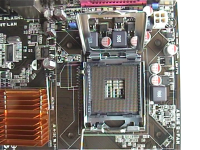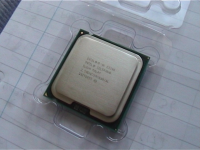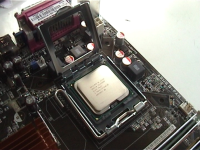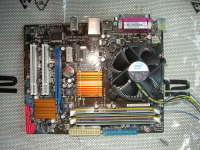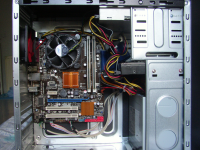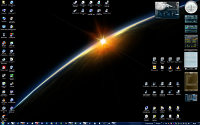Development PC(s) and Network - Introduction

Within the Development PC(s) and Network Section:
- The software I use for development →
- Computer Hardware - Current Systems (2014 - Present) →
- Computer Hardware - Previous Systems (1998 - 2014) →
- Computer Hardware - Historic Systems (Pre-BVE: 1994 - 1998) →
- Office/Lab (2018 - Present)→
- Server Setup (2016 - Present) →
The Intel Celeron E3300 System (2010 - Present)
A low cost, cool and quiet backup PC, which I used for any work which didn't require the power of the Core 2 Quad based system at the time. This microATX PC had lower power consumption, but relied solely on the motherboard's integrated Intel GMA X4500 graphics accelerator for 3D graphics; this gave relatively low 3D gaming performance, and lower image quality when compared to a decent discrete graphics card (due to there being poor antialiasing and limited anisotropic filtering).
This PC was more than good enough for everyday tasks and less demanding 3D applications, such as Google Earth, or viewing objects using openBVE's Object Viewer for example, however with a decent PCIe graphics card installed, this was a very capable system for 3D games or detailed routes in openBVE too, and the dual-core Intel Celeron CPU was actually rather good. The system is currently being rebuilt to be used as an administration and CCTV monitoring workstation. The following openBVE work was being carried out on it:
- Class 323 cross-platform .NET plugin
- Web development
- Birmingham Cross-City South v2.0 (only tasks which don't require a lot of 3D performance)
- Watford Junction to Rugby (only tasks which don't require a lot of 3D performance)
Gallery
Specifications
CPU:
Intel Celeron Dual Core E3300 [Wolfdale-3M Core, 45nm, 2.50GHz, 800MHz FSB, 1MB Cache, R0 Stepping]
-- 3DMark06 (Default Settings) - CPU Score: 2080
-- Windows 7 Experience Index (Processor) - 6.0
SiSoftware Sandra Lite 2010
Aggregate Arithmetic Performance: 21.63 GOPS
Dhrystone ALU: 26.36 GIPS
Whetstone iSSE3: 17 GFLOPS
Cooling: Stock Intel cooler supplied with Core 2 Quad Q9650 CPU (this includes copper, unlike the stock cooler supplied with the Celeron E3300 CPU, so this might be better if the Celeron is overclocked in future - the E3300 runs cool anyway, though).
-- 3DMark06 (Default Settings) - CPU Score: 2080
-- Windows 7 Experience Index (Processor) - 6.0
SiSoftware Sandra Lite 2010
Aggregate Arithmetic Performance: 21.63 GOPS
Dhrystone ALU: 26.36 GIPS
Whetstone iSSE3: 17 GFLOPS
Cooling: Stock Intel cooler supplied with Core 2 Quad Q9650 CPU (this includes copper, unlike the stock cooler supplied with the Celeron E3300 CPU, so this might be better if the Celeron is overclocked in future - the E3300 runs cool anyway, though).
Motherboard:
Asus P5QPL-AM rev. 1.04G, BIOS ver. 0414 [Northbridge: Intel G41 Express (Eaglelake (G)), Southbridge: Intel ICH7; Socket 775, microATX form factor]
RAM:
2GB PC2-6400 DDR2 SDRAM [CL5-5-5-15, Dual channel]
SiSoftware Sandra Lite 2010
Int Buff'd iSSE2 Memory Bandwidth: [4.24 GB/s]
Float Buff'd iSSE2 Memory Bandwidth: [4.28 GB/s]
Memory (Random Access) Latency: [107 ns]
Memory (Linear Access) Latency: [16 ns]
Windows 7 Experience Index (RAM): [5.5]
SiSoftware Sandra Lite 2010
Int Buff'd iSSE2 Memory Bandwidth: [4.24 GB/s]
Float Buff'd iSSE2 Memory Bandwidth: [4.28 GB/s]
Memory (Random Access) Latency: [107 ns]
Memory (Linear Access) Latency: [16 ns]
Windows 7 Experience Index (RAM): [5.5]
Graphics:
Integrated Intel Graphics Media Accelerator (Intel GMA X4500) [BIOS Version: 1800.0]
[Driver version: 8.15.10.2202]
3DMark06 Basic v1.0.2 (Default Settings)
SM2.0 Score: [316]
HDR/SM3.0 Score: [388]
FurMark v1.6.5 (AA: None, AFx2, 1280x1024, Time: 60000ms)
o3Marks: [193]
FPS (min/max/avg.): [3 / 5 / 3]
openBVE framerates
(Windows XP Home Edition, 600m viewing distance, Anisotropic filtering (Sharp), fullscreen 1920x1200, Intel GMA Global Settings/3D Preference: Quality [AA: n/a, AF: 2x]):
Cross-City South v1.31 High Detail, Redditch, with class 323 3D cab: [28 fps]
Cross-City South v1.31 High Detail, Barnt Green, with class 323 3D cab: [19 fps]
Windows 7 Experience Index (Graphics): [4.3]
Information: Many integrated or on-board graphics solutions don't usually perform anywhere near as well as a good graphics card installed in either the PCIe or AGP slot, and the Intel GMA X4500 is suitable only for more simple openBVE routes, or those designed for BVE Trainsim. The image quality is also not as good as what you could see with an ATI or NVIDIA graphics card for example, as there's no antialiasing and only limited anisotropic filtering capability.
Something like my upcoming Watford Junction to Rugby route is too demanding for the Intel GMA X4500, and the route requires something rather better (the Intel Celeron E3300 dual-core CPU is more than good enough however, when paired with the NVIDIA GeForce GTX 260 graphics card, for example).
[Driver version: 8.15.10.2202]
3DMark06 Basic v1.0.2 (Default Settings)
SM2.0 Score: [316]
HDR/SM3.0 Score: [388]
FurMark v1.6.5 (AA: None, AFx2, 1280x1024, Time: 60000ms)
o3Marks: [193]
FPS (min/max/avg.): [3 / 5 / 3]
openBVE framerates
(Windows XP Home Edition, 600m viewing distance, Anisotropic filtering (Sharp), fullscreen 1920x1200, Intel GMA Global Settings/3D Preference: Quality [AA: n/a, AF: 2x]):
Cross-City South v1.31 High Detail, Redditch, with class 323 3D cab: [28 fps]
Cross-City South v1.31 High Detail, Barnt Green, with class 323 3D cab: [19 fps]
Windows 7 Experience Index (Graphics): [4.3]
Information: Many integrated or on-board graphics solutions don't usually perform anywhere near as well as a good graphics card installed in either the PCIe or AGP slot, and the Intel GMA X4500 is suitable only for more simple openBVE routes, or those designed for BVE Trainsim. The image quality is also not as good as what you could see with an ATI or NVIDIA graphics card for example, as there's no antialiasing and only limited anisotropic filtering capability.
Something like my upcoming Watford Junction to Rugby route is too demanding for the Intel GMA X4500, and the route requires something rather better (the Intel Celeron E3300 dual-core CPU is more than good enough however, when paired with the NVIDIA GeForce GTX 260 graphics card, for example).
Audio:
On-board Realtek ALC887 High Definition Audio 6-channel CODEC
Logitech X-230 2.1 Speakers
Logitech X-230 2.1 Speakers
Internal Storage:
Western Digital Caviar Blue WD2500AAKS-00VSA0 250GB 3.5" [SATA-II 3Gb/s, 7200rpm, 16MB Cache, AHCI, Firmware v01.01B01]
ATTO Disk Benchmark (default settings)
Max Read Transfer Rate: [103046 KB/s]
Max Write Transfer Rate: [103443 KB/s]
Min Read Transfer Rate: [4631 KB/s]
Min Write Transfer Rate: [6400 KB/s]
SiSoft Sandra Lite 2010
Read Performance: [49.73 - 101.71 MB/s]
Random access time: [16.49 ms]
Windows 7 Experience Index (Hard Disk): [5.9]
ATTO Disk Benchmark (default settings)
Max Read Transfer Rate: [103046 KB/s]
Max Write Transfer Rate: [103443 KB/s]
Min Read Transfer Rate: [4631 KB/s]
Min Write Transfer Rate: [6400 KB/s]
SiSoft Sandra Lite 2010
Read Performance: [49.73 - 101.71 MB/s]
Random access time: [16.49 ms]
Windows 7 Experience Index (Hard Disk): [5.9]
Optical Storage:
Samsung SH-S223L/BEBE 22x DVD±R, 8x DVD±DL, DVD+RW x8/-RW x6, x12 RAM w. Lightscribe (SATA, Firmware v. SB02)
Display:
Samsung Syncmaster 2443BW 24" 5ms TFT/TN LCD @ 1920x1200 [Samsung panel]
Input:
Microsoft Wired Keyboard 600
Logitech MX400 Performance Laser Mouse
Logitech MX400 Performance Laser Mouse
Case:
CiT 1006, Black micro-ATX Tower Case
Power Supply:
Generic 450 Watt PSU, ATX12V v2.2 [+3.3V: 20A, +5V: 30A, +12V1: 10A, +12V2: 13A]
Internet and LAN:
Atheros L1E Gigabit LAN PCIe (10/100/1000 Mbps)
Operating System(s):
Windows 7 Home Premium 64-Bit
Windows Experience Index: [4.3]
Processor: [6.0]
Memory: [5.5]
Graphics: [4.3]
Gaming graphics: [5.0]
Primary hard disk: [5.9]
Ubuntu 10.04
Windows Experience Index: [4.3]
Processor: [6.0]
Memory: [5.5]
Graphics: [4.3]
Gaming graphics: [5.0]
Primary hard disk: [5.9]
Ubuntu 10.04
Return to the Development PC(s) and Network Menu
Content last updated: 10th April 2019

